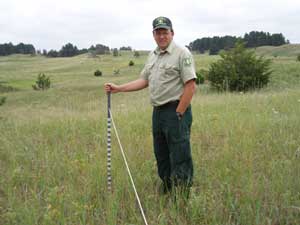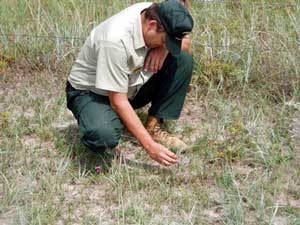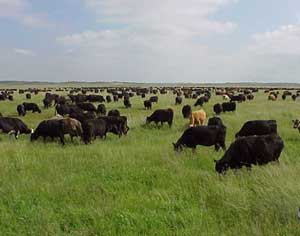

(Walter Schacht, 2005)
| This scenario accompanies the online lesson, 'Perennial Plant Response to Defoliation', and is designed to allow you to apply the concepts learned in that lesson to a real-life problem. Lesson Navigation Tips: - To answer questions, select the button next to the correct answer and then select ’check it’ to see if you are correct. - To review concepts from the Perennial Plant Response to Defoliation lesson, click on the link below each question. - Click once on figures to see enlarged versions. |
Grazing Response:
Tim Griffin is the Rangeland Management Specialist at the Nebraska National Forest, Bessey Range District, Halsey, NE. He is in charge of managing the Forest’s grasslands that are leased to local ranchers for cattle grazing. Based on lease agreements, each rancher is allocated a portion of the Forest’s grasslands for grazing. Tim sets the stocking rates, monitors the use and condition of the grasslands through the grazing season, and works with the ranchers in developing management and improvement plans. Tim is concerned about managing the Forest’s grasslands so that they provide ranchers’ cattle with excellent grazing while maintaining a healthy grassland ecosystem that can have other uses, including wildlife habitat, recreation, and ecotourism.
 |
 |
| Figures 1 & 2. Tim Griffin, Rangeland Management Specialist, evaluating rangeland condition of grazingland on the Nebraska National Forest. (Walter Schacht, 2005) |
|
In late summer, Tim went out to assess the condition of the grasslands and the plant health of desirable grass species. Grass species of particular interest are prairie sandreed and sand bluestem. His attention was drawn to two pastures in a particular allotment that were looking unhealthy: there were few desirable warm-season, mid- and tall grasses, and those remaining were in low vigor. There were eight pastures in this allotment and two herds of cows moved through a fixed sequence of four pastures each. The cattle were moved from one pasture to next every 25 to 40 days. Tim decides to review the grazing schedule records for the past several years to determine why the two pastures are in low condition. Help Tim figure out what’s going wrong and how to fix it by answering these questions.
 |
| Figure 3. Cattle grazing pastures when prairie sandreed and sand bluestem are at the elongation stage in late June and July. (Walter Schacht, 2005) |
| To review this concept click on the link Defoliation of Grasses and Broadleaves. |
| To review this concept click on the link How Perennial Plants Grow. |
| To review this concept click on the link Defoliation of Grasses and Broadleaves. |
| To review this concept click on the link Defoliation of Grasses and Broadleaves. |
| To review this concept click on the link Carbohydrates and Defoliation. |
| To review this concept click on the link Carbohydrates and Defoliation. |
| To review this concept click on the link Carbohydrates and Defoliation. |
| To review this concept click on the link Carbohydrates and Defoliation. |
| To review this concept click on the link Defoliation of Grasses and Broadleaves. |
| To review this concept click on the link Defoliation of Grasses and Broadleaves. |
| To review this concept click on the link How Perennial Plants Grow |
|
||
| To review this concept click on the link How Perennial Plants Grow. |
| To review this concept click on the link How Perennial Plants Grow. |
| To review this concept click on the link How Perennial Plants Grow. |
Clayton Gibbs is the rancher who has the lease on the allotment of concern. Clayton would like work with Tim on improving the range condition of his Forest pastures and accepts the fact that he needs to change the sequence of grazing of the pastures in his allotment. The grazing season on Forest Service leases are from May 20 to October 20 of each year; in other words, ranchers can move cattle onto their lease as early as May 20 and must have the cattle off the leased pastures by October 20. Clayton and Tim agree that the first pastures grazed in the upcoming year will be those that have been grazed historically in late June to late July. Clayton reminds Tim that he usually grazes his first pastures for about 25 days before moving onto the next set of pastures, and then moves back to the first pastures towards the end of the grazing season (around September 30) after the first killing frost. He does this because the first pastures in the sequence recover from the early-season grazing and have much available forage by the end of the season. He likes to take advantage of this forage and have his cattle graze it before removing them from the allotment on October 20.
Development of this lesson was supported in part by the Cooperative State Research, Education, & Extension Service, U.S. Dept of Agriculture under Agreement Number PX2003-06237 administered by Cornell University, Virginia Tech and the American Distance Education Consortium (ADEC) and in part by the New Mexico and Nebraska Agricultural Experiment Stations. Any opinions,findings, conclusions or recommendations expressed in this publication are those of the author(s) and do not necessarily reflect the view of the U.S. Department of Agriculture.